A look at Galileo Galilei's most notable innovations, discoveries and observations in the field of astronomy, physics and other disciplines on the noted Italian physicist, mathematician, engineer, astronomer, and philosopher's 453rd birth anniversary...
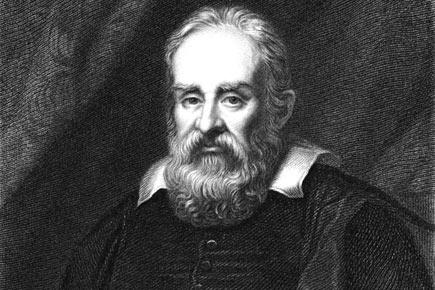
Galileo Galilei, Galileo, telescope, Galilean telescope, thermoscope, Galilean thermometer, inventions, observations, physics, astronomy, The Leaning Tower of Pisa experment, phases of Venus, Jupiter
The thermoscope: One of Galileo Galilei's most noteworthy inventions made around 1593, was the thermoscope, an earlier version of the thermometer. The thermoscope was a device built from a small vase filled with water, attached to a thin vertically rising pipe, with a large empty glass ball at the top. Changes in temperature of the upper ball would exert positive or vacuum pressure on the water below, causing it to rise or lower in the thin column.

Galileo Galilei
However, the thermoscope depended on both temperature and pressure. A group of academics and technicians known as the Accademia del Cimento of Florence, who included Galileo's pupil, Torricelli and Torricelli's pupil Viviani later invented a device known as the Galileo thermometer (pictured below), based on Galileo's principle on which this thermometer is based. It is made of a sealed glass cylinder containing a clear liquid and several glass vessels of varying densities. As temperature changes, the individual floats rise or fall in proportion to their respective density. The outer vessel was filled with 'rectified spirits of wine' (a concentrated solution of ethanol in water); the weights of the glass bubbles were adjusted by grinding a small amount of glass from the sealed end; and a small air space was left at the top of the main vessel to allow for the liquor to expand.
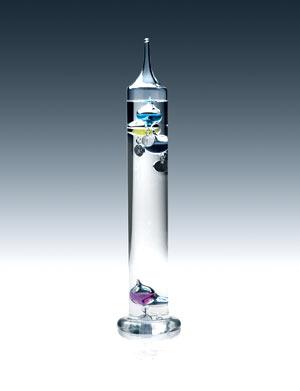
The Galilean thermometer
The device was revived in the modern era by the Natural History Museum, London, which started selling a version in the 1990s.
The telescope: Although the telescope was invented by German-Dutch spectacle-maker Hans Lippershey in 1608, Galileo made a version based on descriptions Lippershey's invention the following year in 1609. Intially capable of about 3x magnification, Galileo later made improved versions with up to about 30x magnification.
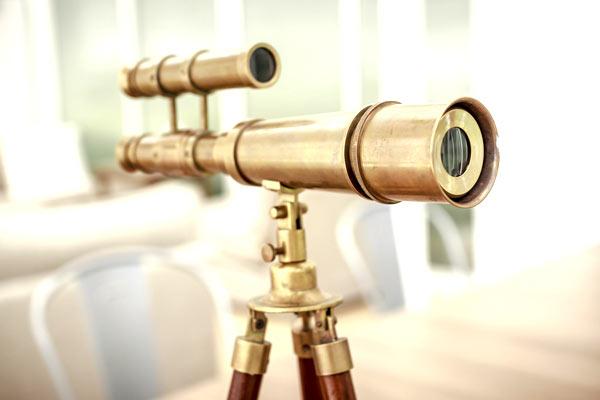
The Galilean telescope. Picture for representational purposes
An observer could see magnified, upright images on the earth with a Galilean telescope, which also came to be known as a refracting telescope. It used a convergent objective lens and a divergent eyepiece lens. Because the design has no intermediary focus, the resulting images were non inverted and upright. Although images were blurry and distorted due to design flaws like the shape of the lens and the narrow field of view, it was still good enough for Galileo to explore the sky. The Galilean telescope could view the phases of Venus, and was able to see craters on the Moon and four moons orbiting Jupiter.
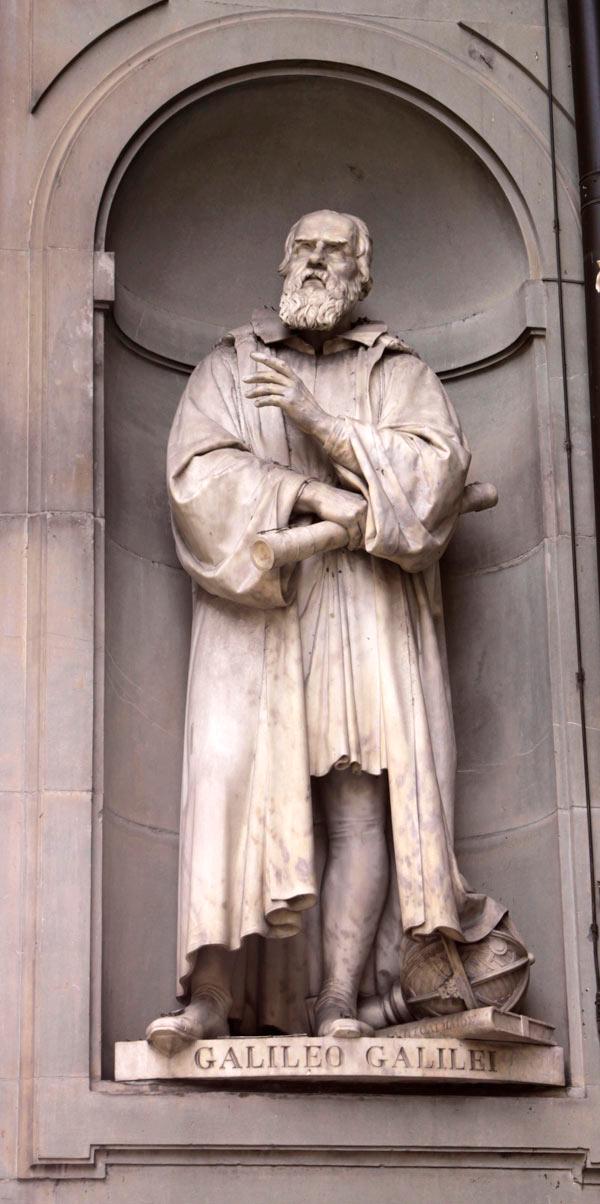
A statue of Galileo Galilei outside the Uffizi Gallery in Florence, Italy
Greek mathematician Giovanni Demisiani coined the name telescope derived from the Greek words tele meaning far and skopein which meant to look or see. The telescope's discovery also led to the discovery of the compound microscope, when Galileo used a telescope at close range to magnify the parts of insects. He gave one of these instruments to Cardinal Zollern in May 1624 for presentation to the Duke of Bavaria and sent another to Prince Cesi in September of that year. Giovanni Faber named Galileo's device, the microscope a year later by combining the Greek words micro, meaning small and skopein, which meant to look at. Illustrations of insects made using one of Galileo's microscopes, and published in 1625, appear to have been the first clear documentation of the use of a compound microscope.
The phases of Venus: Galileo observed that Venus exhibited a full set of phases similar to that of the Moon in September 1610. Nicolaus Copernicus' heliocentric model of the solar system predicted that all phases would be visible since the orbit of Venus around the Sun would cause its illuminated hemisphere to face the Earth when it was on the opposite side of the Sun and to face away from the Earth when it was on the Earth-side of the Sun. This theory was in conflict with Ptolemy's geocentric model, which deemed it impossible for any of the planets' orbits to intersect the spherical shell carrying the Sun. The Ptolemaic model became untenable after Galileo's telescopic observations of the crescent, gibbous and full phases of Venus.

Venus. Pic/AFP
This discovery led a great majority of astronomers to convert to one of the various geo-heliocentric planetary models like such as the Tychonic, Capellan and Extended Capellan models, thus making Galileo's discovery of the phases of Venus arguably his most practically influential contribution to the two-stage transition from full geocentrism to full heliocentrism via geo-heliocentrism.
The moons orbiting Jupiter: Galileo Galilei discovered three of Jupiter's four largest satellites or moons. After discovering the fourth moon on 13th January, he named them the Medicean stars, in honour of his future patron, Cosimo II de' Medici, Grand Duke of Tuscany, and Cosimo's three brothers. They moons were later renamed the Galilean satellites by later astronomers in honour of Galileo. They are now called Io, Europa, Ganymede, and Callisto.

Jupiter. Pic/AFP
The path to the above discovery began on 7th January, 1610, when Galileo had made a telescopic observation about three fixed stars that were totally invisible by their smallness, which were all close to the planet Jupiter and lying on a straight line through it. He later deduced in later days during further observations that they were changing in a way that would have been inexplicable if they had really been fixed stars. He concluded that they were orbiting Jupiter after an observation made on 10 January, where he noted that one of them had disappeared, an observation which he attributed to its being hidden behind Jupiter.
The discoveries of Jupiter's satellites revolutionised astronomy since they did not conform to the principles of Aristotelian cosmology, which stated that all heavenly bodies should circle the Earth.
The discovery of Sunspots: Galileo Galilei bears the credit of being one of the first Europeans to observe sunspots. Although, Johannes Kepler had observed one in 1607 by accident, mistaking it for a transit of Mercury, Galileo was the first to observe and intepret them correctly.

A dispute over priority in the discovery of sunspots, and in their interpretation, led Galileo to a long and bitter feud with the Jesuit Christoph Scheiner; in fact, there is little doubt that both of them were beaten by David Fabricius and his son Johannes.
The craters on the Moon: English mathematician and explorer Thomas Harriot had already observed the moon using a device he dubbed as 'perspective tube'. This was before the invention of the Galilean telescope. Although noting a 'strange spottednesse' in the waning of the moon's crescent in his observations, Harriot was unable to determine its cause.

Galileo, thanks in part to his artistic training and the knowledge of chiaroscuro, was able to discern that the patterns of light and shadow were in fact topographical markers and thus was able to conclude that the cause of the uneven waning as light occlusion from lunar mountains and craters. Galileo's observation of the moon's craters disproved the Aristotlean theory about the moon being a translucent and perfect sphere. This was suitable for use by gunners and surveyors.
The military compass: Galileo devised and improved a Geometric and Military Compass between 1595 and 1598. The device was created after expanding on earlier instruments designed by Niccolò Tartaglia and Guidobaldo del Monte.

Galileo's miliitary compass. Pic courtesy/YouTube
Galileo's military compass offered gunners a new and safer way of elevating cannons accurately and enabled them to quickly compute the charge of gunpowder for cannonballs of different sizes, materials. Instrument maker Marc'Antonio Mazzoleni produced more than 100 of these compasses under Galileo's direction, which the inventor sold for 50 lire. Galileo also included an instruction manual along with the compass and offered a course of instruction in the use of the compasses for 120 lire.
The Leaning Tower of Pisa experiment: Galileo Galilei's most significant breakthrough in the theory of gravity came in 1589 when during an experiment he dropped balls of the same material, but different masses, from the Leaning Tower of Pisa to demonstrate that their time of descent was independent of their mass. This opposed Aristotle's belief that heavy objects fall faster than lighter ones, in direct proportion to weight. The experiment recounted in Galileo's pupil Vincenzo Viviani's biographic is subject of dispute since there is no account by Galileo himself of such an experiment. However most of Stevin's experiments with falling bodies were carried out using inclined planes where both the issues of timing and wind resistance were much reduced.
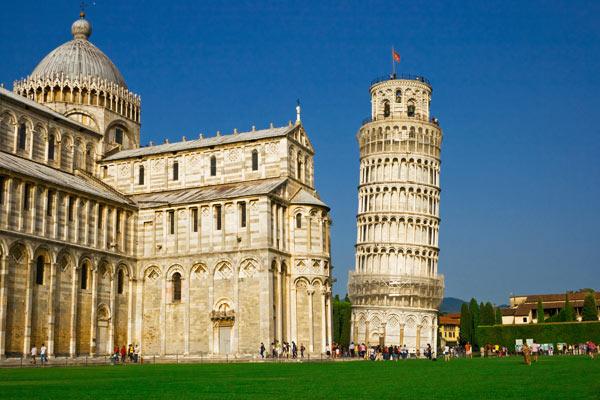
The Leaning Tower of Pisa (right)
According to one source, the experiment did indeed take place but was actually performed by Simon Stevin at the church tower in Delft in 1586.
The discovery of the Milky Way: Galileo discovered, the Milky Way, the galaxy that contains our Solar System by deducing that the band of light observed across the night sky to be a multitude of stars packed so densely that they appeared from Earth to be clouds. Galileo reported his observations in his pamphlet, the Starry Messenger. He stated that the stars appeared as mere blazes of light, essentially unaltered in appearance by the telescope, and contrasted them to planets, which the telescope revealed to be discs.

Galileo located many other stars too distant to be visible with the naked eye like the double star Mizar in Ursa Major, which he observed in 1617.
 Subscribe today by clicking the link and stay updated with the latest news!" Click here!
Subscribe today by clicking the link and stay updated with the latest news!" Click here!









